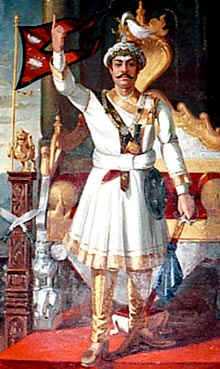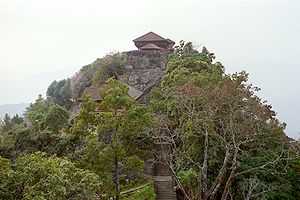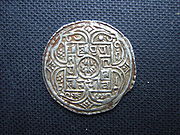Prithvi Narayan Shah
| king Prithvi Narayan Shah पृथ्वीनारायण शाह | |
|---|---|
| unifier & King of Nepal | |
 | |
| Reign | 25 September 1743 – 11 January 1775 |
| Coronation | 25 September 1768[1] |
| Predecessor | Nara Bhupal Shah |
| Successor | Pratap Singh Shah |
| Spouse |
Indra Kumari Devi Narendra Rajya Laxmi Devi Icchavati Devi Dayavati Devi |
| Issue | Bahadur Shah |
| Dynasty | Shah dynasty |
| Father | Nara Bhupal Shah |
| Mother | Kaushalyawati Shah |
| Born |
11 January 1723[2] Gorkha, Nepal |
| Died |
11 January 1775 (aged 52) Devighat,Nuwakot, Nepal |
| Religion | Hinduism |
Prithvi Narayan Shah, Rajput King of Nepal (1723[3]–1775; Nepali: वडामहाराजधिराज पृथ्वीनारायण शाह) was the first king of the unified Nepal. He is credited for starting the campaign for a unified Nepal, which had been divided and weakened under Malla confederacy.[4] He was the ninth generation descendant of Dravya Shah (1559–1570), the founder of the ruling house of Gorkha. Prithvi Narayan Shah succeeded his father, King Nara Bhupal Shah to the throne of the Gorkha Kingdom in 1743.
Early life
Badamaharajdhiraj Prithvi Narayan Shah was of Khas race. His mother was Kaushwalyawati Shah but he was cared for by Chandra Pravawati, the 1st queen of King Nara Bhupal Shah. He started taking general interest in the affairs of the state because his father spent most of his time praying. He had a great dream to win over Nuwakot, partially because his father had lost a war with Nuwakot. After the death of his father in 1799 BS, Prithivi Narayan Shah ascended the throne of Gorkha at the age of twenty. Walking around Gorkha and talking to people about the general concerns of the palace was his passion and this helped him to understand the needs of the citizens of Gorkha.[5]

Unification of Nepal
King Prithvi Narayan Shah's reign began with the defeat at Nuwakot, which lies between Kathmandu and Gorkha District. He won Nuwakot in the subsequent attempt in 1744. After Nuwakot, he took possession of strategic points in the hills surrounding the Kathmandu Valley. The valley's communications with the outside world were thus cut off. The occupation of the Kuti Pass in about 1756 stopped the valley's trade with Tibet. Also he had stopped the trade between the Newar people living in the Kathmandu Valley and the Muslim Mughal Empire in India.
After two humiliating defeats, King Prithvi Narayan Shah conquered Kirtipur on his third attempt. Finally, King Prithvi Narayan Shah entered the valley, after conquering Kirtipur. Consequently Jaya Prakash Malla of Kathmandu managed to escape with his wife and took asylum in Patan, Lalitpur. When the conquest was extended to Patan a few weeks later both Jaya Prakash Malla and the King of Patan, Tej Narsingh Malla, took refuge in Bhaktapur, which was also conquered after some time.
Death and Legacy
King Prithvi Narayaṇ Shah managed to unify small principalities into one nation, Nepal. The unification was crucial as the British colonial forces had already started colonizing small kingdoms that formed present India. King Prithivi Narayan Shah was convinced that the British forces would slowly come for Nepal and as the present day Nepal was divided into more than 50 small principalities it would be very easy for the British to colonize Nepal. His unification campaign was very ambitious, especially as he was the King of a small kingdom surrounded by strong and powerful neighbors. But King Prithivi Narayan Shah was able to unify Nepal and later the Nepali forces were able to fight against British colonial forces and prevent colonization of Nepal. He died before he could effectively organize the administration of his new country. He died in January, 1775 at the age of 52. Upon his death, Prithvi Narayan Shah was succeeded by his son, Pratap Singh Shah and his unification campaign was continued by his younger son Bahadur Shah.Then after the campaign of unification laid sown the resulting present Nepal.
Divya Upadesh
In addition to the unification of Nepal, King Prithivi Narayan Shah laid out the guiding principles of governance, nationalism, and foreign policy. In his Divya Upadesh he laid out nine principles.
Gallery images
-
Portrait of the King (Currently at Hanuman Dhoka Durbar Square)
-
Mohar silver coin of Prithvi Narayan Shah, struck in Saka Era 1685 (AD 1763) when he was king of Patan. (Obverse)
-
Mohar silver coin of Prithvi Narayan Shah, struck in Saka Era 1685 (AD 1763) when he was king of Patan. (Reverse)
Notes and references
- ↑ Royal Ark
- ↑ Acharya, Baburam. Shree Panch BadaMaharajdhiraj Prithivi Narayan Shah ko Sanxipta Jiwani, Part I (in Nepali). p. 42.
- ↑ Accordingly Royal Ark, he was born on 25 December 1722
- ↑ Manandhar, Triratna. Nepal ko Ekikaran (in Nepali). Kathmandu: Sajha Prakashan. p. 215.
- ↑ Gyawali, Suryavikram. PrithiviNarayan Shah (in Nepali). Darjeeling: Nepal SahiSammelan.
External links
| Wikimedia Commons has media related to Prithvi Narayan Shah. |
| Prithvi Narayan Shah Born: 7 January 1723 Died: 11 January 1775 | ||
| Regnal titles | ||
|---|---|---|
| Preceded by Nara Bhupal Shah |
King of Gorkha 1743–1768 |
Succeeded by Himself as King of Nepal |
| Preceded by Himself as King of Gorkha |
King of Nepal 1768–1775 |
Succeeded by Pratap Singh Shah |


